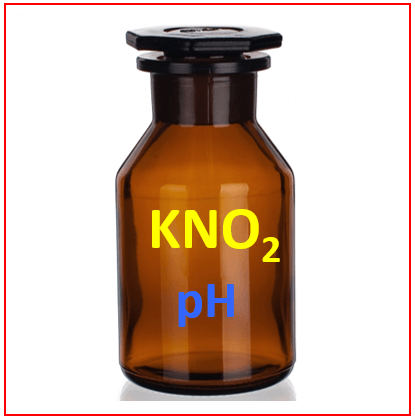Calculate the pH of a 0.35 M solution of KNO2 (Ka = 4.0 x 10-4).
KNO2 is a salt of a strong base KOH and a weak acid HNO2 and therefore, the solution will be basic.
Dissociate the salt and write the reaction of its weak component with water.
KNO2 → K+ + NO2–
NO2–(aq) + H2O(l) → HNO2(aq) + OH–(aq) (basic)
Next, determine the Kb from the Ka:
Ka · Kb = Kw = 10-14
Rearranging this, we get an expression for Ka:
\[{K_{{\rm{b}}}}\; = \,\frac{{{K_{\rm{w}}}}}{{{K_{\rm{a}}}}}\; = \;\frac{{{\rm{1}}{{\rm{0}}^{{\rm{ – 14}}}}}}{{{\rm{4}}{\rm{.0}}\; \times \;{\rm{1}}{{\rm{0}}^{{\rm{ – 4}}}}}}\; = \;{\rm{2}}{\rm{.5 }} \times {\rm{ 1}}{{\rm{0}}^{{\rm{ – 11}}}}\]
Set up an ICE table for Kb assigning x mol/l for the ionization.
|
|
[NO2–] |
[HNO2] |
[OH–] |
|
Initial |
0.35 |
0 |
0 |
|
Change |
-x |
+x |
+x |
|
Equil |
0.35 – x |
x |
x |
Write the expression for Kb using the equilibrium concentrations in the ICE table in order to determine the [OH–].
\[{K_{{\rm{b}}}}\; = \,\frac{{{\rm{[HN}}{{\rm{O}}_{\rm{2}}}{\rm{][O}}{{\rm{H}}^{\rm{ – }}}{\rm{]}}}}{{{\rm{[N}}{{\rm{O}}_{\rm{2}}}^{\rm{ – }}{\rm{]}}}}\;{\rm{ = }}\;\frac{{{{\rm{x}}^{\rm{2}}}}}{{{\rm{0}}{\rm{.35}}\;{\rm{ – }}\;{\rm{x}}}}\; \approx \;\frac{{{{\rm{x}}^{\rm{2}}}}}{{{\rm{0}}{\rm{.35}}}}{\rm{ = }}\;{\rm{2}}{\rm{.5}}\;{\rm{ \times }}\,{\rm{1}}{{\rm{0}}^{{\rm{ – 11}}}}\]
Solving for x, we find that x = 3.0 x 10-6 mol/L, and we check if the approximation was valid:
\[\% \, = \;\frac{{3.0\, \times \;{{10}^{ – 6}}}}{{0.35}}\; \times \;100\% \; = \;0.00084\% \]
The approximation is valid, so the concentration of OH– ions at equilibrium is 3.0 x 10-6 M.
We can now calculate the pOH, and then pH using the pH + pH = 14 relationship:
pOH = -log 3.0 x 10-6 = 5.5, and therefore, the pH is:
pH = 14 – pOH = 14 – 5.5 = 8.5
And this answer is also reasonable because we predicted a basic solution.
Check Also
- Definitions of Acids and Bases
- Acid-Base Reactions
- Acid-Base Titrations
- Conjugate Acid and Conjugate Base
- Autoionization of Water and Kw
- The pH and Acidity
- Acid Strength, Ka, and pKa
- Base Strength, Kb, and pKb
- Ka, pKa, Kb, and pKb Relationship
- The pH of a Strong Acid and Base
- pH + pOH = 14
- The pH of a Weak Acid
- The pH of a Weak Base
- The pH of Polyprotic Acids
- The acidity of a Salt Solution
- The pH of a Salt Solution
- The pH of Salts With Acidic Cations and Basic Anions
- pH Practice Problems
- Acids and Bases Practice Problems
Acids and Bases Quiz

